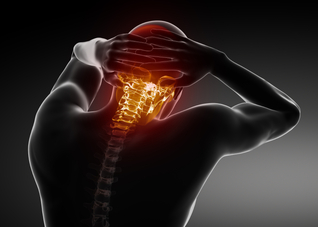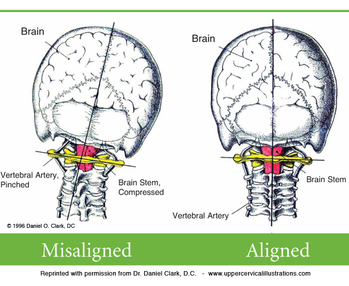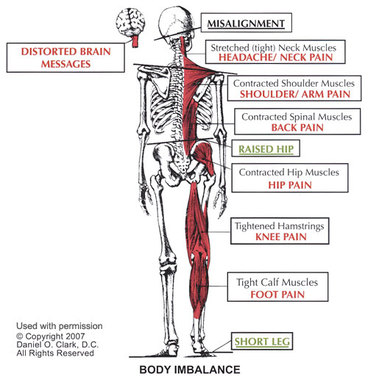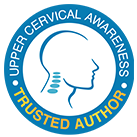Occipital neuralgia
|
Suffer With Occipital Neuralgia, Occipital Headache or Pain?
A Misalignment In The Upper Neck Is A Common Cause!
 figure 1: Occipital Neuralgia & Upper Neck Pain
figure 1: Occipital Neuralgia & Upper Neck Pain
Occipital Neuralgia is one of the most common conditions that people frequently confuse with migraines and other types of headaches due to the fact that THE SYMPTOMS ARE VERY SIMILAR! Occipital Neuralgia is a neurological condition that occurs due to the inflammation and irritation of the nerves exiting from the top of your spinal cord through the top of your neck, and back up onto the back of the head also called the occiput. The pain sensation travels along the path of the occipital nerves.
Occipital Neuralgia simply put is nerve pain that radiates onto the back of the head.
If you have been diagnosed with Occipital Neuralgia or are experiencing pain in the back of your head or upper neck area we hope this will seem like common sense.
Occipital Neuralgia simply put is nerve pain that radiates onto the back of the head.
If you have been diagnosed with Occipital Neuralgia or are experiencing pain in the back of your head or upper neck area we hope this will seem like common sense.
Symptoms of Occipital Neuralgia?
Occipital Neuralgia can cause a really sharp stinging feeling which is accompanied by an intense sharp pain at the back of the head and the neck.
Common symptoms for Occipital Neuralgia include:
- Throbbing pain that starts at the base of the head and radiates to the scalp
- Pain in the upper neck where the head and neck meet
- Pain can also radiate behind the ear
- An unusually tender scalp
- Pain behind either one of your eyes
- Heightened sensitivity to light
Common symptoms for Occipital Neuralgia include:
- Throbbing pain that starts at the base of the head and radiates to the scalp
- Pain in the upper neck where the head and neck meet
- Pain can also radiate behind the ear
- An unusually tender scalp
- Pain behind either one of your eyes
- Heightened sensitivity to light
Subluxation Induced Occipital Neuralgia

An injury to the neck due to some sort of accident such as: a hard slip or fall, a car wreck, or sports injury etc. can tear loose the connective tissues that hold your spine together allowing the upper neck to misalign and lock out into a stressed position. It is quite remarkable how months or even years later symptoms will start to develop and progress over time. The reason being that injuries to the neck very commonly result in the misalignment of one of the two top neck bones, commonly known as Atlas or Axis; this leads to irritation and pressure in and around the brain stem, and upper spinal cord, which is the junction between the brain and the body.
The brain stem ends where the spinal cord begins, and the spinal cord is literally a bunch of nerves that tell the body what to do. Every signal is emitted from the brain stem as the master control center of the body and the spinal cord nerves are just used as a channel to convey the signals throughout the body.
A misalignment in the upper neck affects you in two ways. First, your brain is unable to communicate with the rest of your body adequately, and secondly, a misalignment in the upper neck alters your center of gravity. When your head goes off-center, your spine creates abnormal curvatures below to compensate, and this results in the loss of normal spinal curves over time. This relates to the spinal cord in that; if you lose your normal spinal curves, then you lose the extra slack in the spinal canal and your nerves exiting along the spine can end up being under tension in certain areas of the spine, much like tightening a guitar string. Your unique spinal anatomy will dictate where that tension ends up.
The brain stem ends where the spinal cord begins, and the spinal cord is literally a bunch of nerves that tell the body what to do. Every signal is emitted from the brain stem as the master control center of the body and the spinal cord nerves are just used as a channel to convey the signals throughout the body.
A misalignment in the upper neck affects you in two ways. First, your brain is unable to communicate with the rest of your body adequately, and secondly, a misalignment in the upper neck alters your center of gravity. When your head goes off-center, your spine creates abnormal curvatures below to compensate, and this results in the loss of normal spinal curves over time. This relates to the spinal cord in that; if you lose your normal spinal curves, then you lose the extra slack in the spinal canal and your nerves exiting along the spine can end up being under tension in certain areas of the spine, much like tightening a guitar string. Your unique spinal anatomy will dictate where that tension ends up.

The 3 most common spinal compensation areas that come under high stress in the human spinal column are:
1. The upper neck
2. The lower neck, upper back and shoulder area
3. The lower back and hip area
Over time these high stress areas will become inflamed, symptoms will develop, and the spine will start to degenerate. Please note that what you may see in any anatomy textbook only occurs 30% of the time at best meaning 70% of the time spinal structures are highly variable, and especially cranial nerves and spinal nerves. Spinal nerves can begin and end in many different variations.
With Occipital Neuralgia there are 3 nerves we need to consider:
1. The suboccipital nerve - originates between Atlas or C1 and the Occiput.
2. The greater occipital nerve - originates between Atlas and Axis or C1 and C2.
3. The lesser occipital nerve - originates between Axis or C2 and C3.
Is it possible that an old injury to the neck has resulted in spinal misalignment and over the months and years since then the chronic irritation to one or all of the occipital nerves has resulted in pain in the back of your head that now radiates?
1. The upper neck
2. The lower neck, upper back and shoulder area
3. The lower back and hip area
Over time these high stress areas will become inflamed, symptoms will develop, and the spine will start to degenerate. Please note that what you may see in any anatomy textbook only occurs 30% of the time at best meaning 70% of the time spinal structures are highly variable, and especially cranial nerves and spinal nerves. Spinal nerves can begin and end in many different variations.
With Occipital Neuralgia there are 3 nerves we need to consider:
1. The suboccipital nerve - originates between Atlas or C1 and the Occiput.
2. The greater occipital nerve - originates between Atlas and Axis or C1 and C2.
3. The lesser occipital nerve - originates between Axis or C2 and C3.
Is it possible that an old injury to the neck has resulted in spinal misalignment and over the months and years since then the chronic irritation to one or all of the occipital nerves has resulted in pain in the back of your head that now radiates?
Upper Cervical Care For The Correction of Subluxation
Upper Cervical Chiropractic care is a systematic approach to locate, and correct injuries to the upper neck. This is achieved by a procedure that is designed to:
1. determine the nature and extent of the spinal injury,
2. determine disruption to nervous system function using a form of thermography,
3. determine how long the spinal injury has been present and the prospects for correction.
It is important to also note that Subluxation may not be the only cause of Occipital Neuralgia. According to the National Institute of Health treatment options include mainly drug therapies such as: anti-inflammatories, muscle relaxers, anti-depressants, nerve blocks, and steroid injections.
We hope you can see through this and realize that these therapies are designed to only cover up your symptoms. Anti-inflammatories, muscle relaxers, anti-depressants, nerve blocks, steroid injections, etc. will not fix a structural problem. To give you an example lets say your shoulder is dislocated, are any of the above therapies going to re-locate your shoulder? With that said the most commonly overlooked source of these problems is in fact due to a Subluxation that occurred due to a previous neck injury. The bottom line is that a Subluxation is a neuro-vascular disorder that interferes with the nervous systems ability to communicate back and forth with the body and therefore produces some sort of dysfunction.
What type of problem develops from a Subluxation depends on a several different factors such as:
1. the nature and extent of the spinal injury,
2. how long has the injury been present?,
3. most importantly the patients unique anatomy in the upper cervical spinal area.
1. determine the nature and extent of the spinal injury,
2. determine disruption to nervous system function using a form of thermography,
3. determine how long the spinal injury has been present and the prospects for correction.
It is important to also note that Subluxation may not be the only cause of Occipital Neuralgia. According to the National Institute of Health treatment options include mainly drug therapies such as: anti-inflammatories, muscle relaxers, anti-depressants, nerve blocks, and steroid injections.
We hope you can see through this and realize that these therapies are designed to only cover up your symptoms. Anti-inflammatories, muscle relaxers, anti-depressants, nerve blocks, steroid injections, etc. will not fix a structural problem. To give you an example lets say your shoulder is dislocated, are any of the above therapies going to re-locate your shoulder? With that said the most commonly overlooked source of these problems is in fact due to a Subluxation that occurred due to a previous neck injury. The bottom line is that a Subluxation is a neuro-vascular disorder that interferes with the nervous systems ability to communicate back and forth with the body and therefore produces some sort of dysfunction.
What type of problem develops from a Subluxation depends on a several different factors such as:
1. the nature and extent of the spinal injury,
2. how long has the injury been present?,
3. most importantly the patients unique anatomy in the upper cervical spinal area.
Are You A Candidate For Upper Cervical Care?
Dr. Grayson Blom works with a nationwide group of Doctors expertly trained and specializing in the Upper Cervical Procedure. Dr. Blom is also one of the few Doctors in the state of Idaho trained and certified in the Upper Cervical Procedure. We are dedicated to helping patients just like you, who suffer from occipital neuralgia, headaches, migraines, neck pain, shoulder pain, back pain, and other spinal-related disorders.
To schedule an appointment with Dr. Blom to determine if you are a candidate for upper cervical care please give us a call at (208) 559-0541 or click the link below.
To schedule an appointment with Dr. Blom to determine if you are a candidate for upper cervical care please give us a call at (208) 559-0541 or click the link below.


